 |
Municipal Auditorium
San Antonio, TX

Municipal Auditorium - San Antonio, TX- ca.1920s
Photo courtesy
San Antonio Public
Library
The Municipal Auditorium in downtown San Antonio is located at 100 Auditorium Circle, six blocks from the Alamo. It was built in 1926 and dedicated to the memory of the veterans of the first World War. The Spanish Colonial Revival building with yellow-tiled Byzantine domes cost $1,200,000 to build and was designed by
Atlee B. Ayres
in association with Emmett Jackson and George Willis, all of whom received the American Institute of Architects Gold Medal in
1929.1

Municipal Auditorium - San Antonio, TX- ca.1928
Photo by Austin Seymour Masterson, courtesy
Institute of Texan Cultures, loaned by Martha N. Bradley
At the time it occupied 6 1/2 acres, has several rooms and areas for banquets, meetings and expositions. The main auditorium originally sat 6,500 and the stage is 75 feet by 44 feet with a
proscenium height of 37 feet with decorative organ grills on either side of it. The orchestra pit can be hydraulically adjusted to standing height, sitting height, or stage level. The Auditorium has been used to hold concerts, graduations, conventions and Fiesta coronations since opening.2
The Auditorium floor was designed so that it could be used in a flat
configuration for dances and performances or tilted for more of a
theater setting.
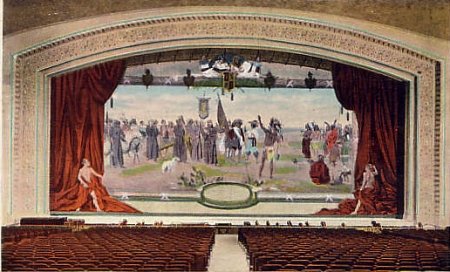
36-by-75-foot Stage curtain depicting the founding of San
Antonio in 1718
Post card Photo courtesy web
The Auditorium has been the site of civil unrest too when on August 25, 1939 the greatest exhibition of mob violence and vandalism in the city's history erupted when demonstrators
condemned the action of the city in granting a permit to the Communist party for a rally in the structure dedicated as a war memorial.3
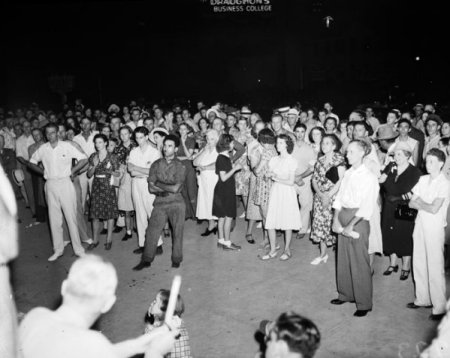
demonstrators outside Municipal Auditorium - Aug. 25,
1939
Photo © Institute of Texan Cultures
Lining the circle of violent mobsters were several thousand people, onlookers from
social events in nearby hotels who took little part in either the cheering or rock-throwing. As the mob converged on the east wing entrance, firemen rushed forward with fire hoses given force from a pumper truck parked in the basement
of the auditorium and felled several people and forced others to retreat.3
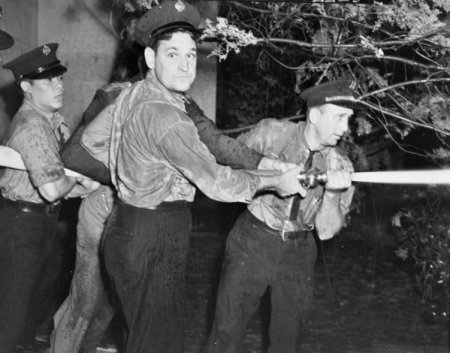
Firemen spray the mob outside Municipal Auditorium - Aug.
25, 1939
Photo by George Bartholomew © Institute of Texan Cultures
Seventeen were identified injured in the wake of the mass hysteria participated in by a
reported crowd of 10,000. George Bartholomew, a photographer for the San Antonio Light, was the first casualty while attempting to focus his camera on a stream of water and struck on the back of the head with a brick, knocking him to the street, unconscious.3
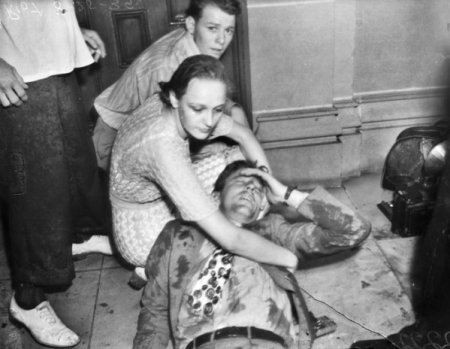
George Bartholomew injured. Alice Potter, reporter's wife, at his
side - Aug. 25, 1939
Photo © Institute of Texan Cultures
A group rushed to carry him back to the front entrance and the mob surged forward in sympathy, manhandling him in an attempt to carry him away before police opened a way and he was taken to Medical and Surgical Hospital.3
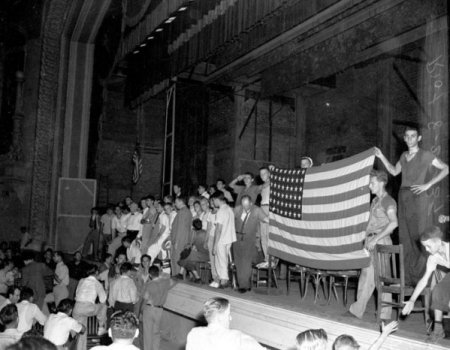
Rioters display U.S. flag at ''Americanism Rally'' - Aug.
25, 1939
Photo © Institute of Texan Cultures
Alexander Boynton, former Republican candidate for governor, called to the crowd to come inside after rioters had filled the auditorium and
launched an Americanism rally. The American flag taken from the east room where the communist meeting was held was stretched across the stage during the rally.3

Johnson takes off coat, loosens tie as words fly - June
26, 1941
Photo © Institute of Texan Cultures
On June 26, 1941 Lyndon B. Johnson, a U.S. Congressman at the time, while campaigning for a seat in the U.S. Senate gave a special speech in the
Municipal Auditorium after giving a radio speech out front.3 Johnson would later become John F. Kennedy's running mate and Vice President in his administration and subsequently the 36th President of the United States after Kennedy's
assassination.

Marian Anderson entertaining a group of overseas veterans
at the Auditorium - 1945
Photo © DiscoverBlackHeritage

postcard of the Municipal Auditorium -1947
Photo courtesy Classic
Postcards
Prior to the opening of the Bexar County Coliseum in
1949, the auditorium was the site of nearly every major event in San
Antonio, from concerts and symphony performances to circuses and boxing
matches.


ads for 1st San Antonio appearance
courtesy Andy Crews and the
San Antonio Public
Library
On January 15, 1956,
Elvis, Scotty, Bill and DJ made their first of three appearances in San
Antonio, two of which were at the Auditorium, as an extra added
attraction to a Grand Ole Opry Show with Hank Snow. The January
11th edition of the San Antonio News had a small article that read:
Hillbilly Bopster In Show Here
Elvis Presley, 20-year-old fireball from "Louisiana
Hayride," will make personal appearances with "Grand Old Opry" at
Municipal Auditorium at 2 p.m. and 8. P.m Sunday. His specialty is
combining country music with bop.
Presley, with his musical sidekicks Scotty Moore and Bill Black, came
upon his career by accident when a recording manager heard him making a
personal record, and was so impressed that he signed him up to make
records.
The success of "That's All Right Mama" and "Blue Moon of Kentucky"
started a series of hits including "I Don't Care If the Sun Don't
Shine," "Good Rockin' Tonight" and his latest releases, "You're a
Heartbreaker" and "Milk Cow Blues Boogie." Elvis also does a number of
novel and rhythmic tunes on his shows that he has not recorded.
Scotty Moore plays the "hot" guitar, and Bill Black thumps the bass, and
tells yarns on the other boys on the shows.
San Antonio News - January 11, 1956
courtesy Andy Crews and the
San Antonio Public
Library
Their
appearance there was only days after their first recording session with RCA
in Nashville when they recorded, among others, "Heartbreak
Hotel," and only days before their first national television
appearance on the Dorsey Brother's Stageshow.

Hank Snow and RCA distributor Perry Shankle Jr. Jan 15,
1956
News Photo courtesy Andy Crews and the
San Antonio Public
Library
Though by now fairly well known in Texas, at least
regionally, the show evidently didn't warrant any coverage in the local
papers. There was a picture in the San Antonio News on the 17th however of
Hank Snow with Perry Shankle Jr. during an RCA artist reception that
Sunday captioned Recording Star Visits. The Perry Shankle
Co. was the RCA distributor in South Texas and the reception was to
introduce Snow to dealers.
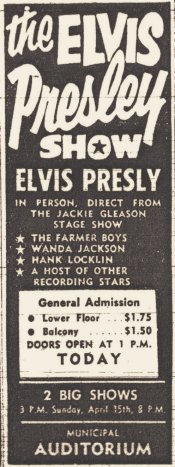
ad for 2nd San Antonio appearance
courtesy Andy Crews
By the time of their second appearance in San Antonio, only a few
months later on April 15, 1956, they were the headliners. The show
was emceed by Charlie Walker. This
appearance also followed a recording session in Nashville the day prior,
where Elvis was presented with a Gold Record for one million records sold
of Heartbreak Hotel. They had flown in to San Antonio on
the day of the show from Memphis aboard a commercial flight and stayed
at the Robert E. Lee Hotel in downtown San Antonio, the same place as
their first appearance in January.
The review in the San Antonio Light was as follows:
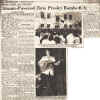 AGONY, SWEET AND COMPLETE AGONY, SWEET AND COMPLETE
Atomic-Powered Elvis Presley Bombs S.A.
By Betty Scheibl
A gum-chewing, nonchalant phenomenon named Elvis Presley moseyed off to
Corpus Christi Monday to see what he could do in the way of searing the souls of additional thousands.
Behind him he left tears, screams, wild applause, mangled emotions--in short, agony, sweet and complete. It was a traumatic experience this newly arrived singing star brought to municipal
auditorium Sunday afternoon and night. Youthful sufferers to the number of
12,000 writhed
through it in sheerest ecstasy.

Elvis in the dressing at the San Antonio Municipal
Auditorium - Apr 15, 1956
Photos courtesy Kay Wheeler
Commented Elvis backstage, sipping a soft drink before the first performance:
"This is just a dream. It makes you feel good. I've got everything a boy ever dreamed of
having."
3 CADILLACS
"Everything" to` the fans doesn't mean exactly what it does to Presley—his three Cadillacs (the fourth on order), his sports car, motorcycle and new house In Memphis. It's something on an entirely different plane, and its potent enough to keep teenagers standing in line for three hours to get in to see him and then hang around
in hordes to catch the second show. Some fans were even determined to follow him to Corpus Monday. Why the passion for Presley?
Squealed one girl:
“Because he looks so mean!"
The boy with the socko scowl, who can say "Yes, ma'am" politely and bestow lingering kisses with equal facility, strolled onstage for the first time at about 4:30 p. m., following a string of western entertainment that included Wanda
Jackson, Hank Locklin, Charlie Walker, the Farmer Boys, Leon Payne, the Texas Cool Cats and several others.
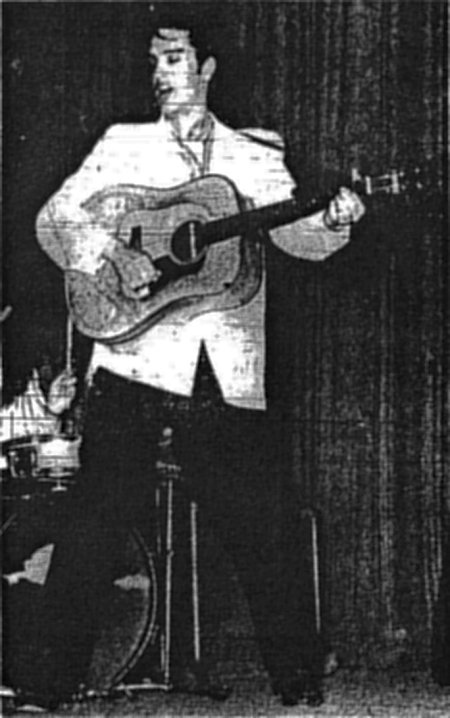
Elvis onstage at the Municipal Auditorium in San
Antonio - Apr 15, 1956
Photo by Eddie Goodman
SINCE 3
The show had been rocking the house since 3 p. m.
Elvis, 21, an ex-truck driver, was wearing a while silk jacket, black trousers and a blue satin shirt with a mandarin collar. Diligent
research uncovered that he sang "Baby, Let's Play House," "Heartbreak Hotel," "Long Tall Sally," "I Was the One," "I Got a Woman," "Only You," "Blue Suede Shoes," "Money Honey" and "'Tutti Frutti."
You couldn't hear Elvis on the front row.
Uproar exploded each time he looked as though he might open his mouth. A flash of white teeth from Elvis, a
loose hipped slur of dance steps, a Brando-like gaze from soulful blue eyes, and the floor vibrated with 6000 stamping feet, whistles shattered the air.
Cries of “Look this way, Elvis" and “Here, over here!" drowned Elvis out. Lipreaders jumping out of their seats in the vicinity of this reporter obligingly supplied the song titles.
ATOMIC POWER
Presley is billed as the "nation's only atomic powered singer"' and the program says his specialty is "a peculiar brand of western bop."
That may or may not be true. I didn't hear him.
But visually from across the footlights he comes through like the midnight express. He kicks, slinks,
shimmies and gyrates.
At times he resembles a man who is desperately wrestling his way out of a particularly confining batch of salt water taffy.
Ten policemen were on duty inside the auditorium for the Presley show. Seven of them were down in from
when the star came on, holding back the crowds (mostly girls) that threatened to surge across the orchestra pit and up on the stage.
Earlier the floor between the first row and the pit was a. sea of full skirts as Elvis worshippers crouched and crawled into position, cameras at the ready. They had to move back.
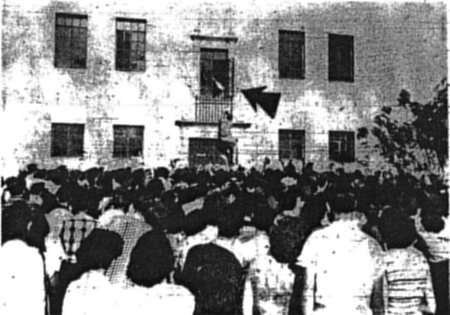
a fan climbs to an upstairs window for Elvis'
autograph
Photo by Eddie Goodman
WE WANT ELVIS
After the show a throng estimated at 3500 jammed against the west stagedoor entrance, chanting 'We want Elvis!" Plans to sign autographs from a table inside the door were abandoned when one girl fainted (she was dragged inside and revived by a policeman with an icebag and Elvis) and others burst into tears.
Presley waved to the screaming crowd from an upstairs window. One enterprising boy climbed up the shrubbery and won an autograph. A few autographs had been dispensed earlier to girls from Dallas and Austin representing the state's Presley fan club, largest in the world with 3000 members.
One girl who said it was her birthday was rewarded with a long kiss. Others got brotherly busses on the cheek. pats on the cheek, pats on the shoulder and squeezes.
At 6 p. m. the mob had not thinned sufficiently to permit Presley to leave the auditorium. He amused himself at the organ, calmly running through "Silent Night," "Harbor Lights" and several other tunes while the teenage public pined outside.
REAL GOOD
He plays by ear, used to sing in the choir in his native town of Tupelo, Miss., feels "real good" when he gets three or four hours sleep a night, never gets excited over anything, except maybe the fact his "Heartbreak Hotel" has just sold 1,000,000 records. He is under 7-year contract to Paramount.
Has he had any proposals since his rapid rise to fame in the past six months? Replies Presley:
"I'd hate to say yes I'd be conceited, and I'd hate to say no 'cause I'd be
lyin'."
If diplomacy counts in show business, Presley should be up there in the front ranks for some time.
San Antonio Light - April 16, 1956
courtesy Andy Crews and the
San Antonio Public
Library
As is obvious in the review, Elvis had been dubbed
"the Atomic-Powered Singer" weeks before his debut in
Nevada, home of Atomic testing, at the New
Frontier Hotel in Las Vegas. This show was emceed by Charlie
Walker and is also where Kay
Wheeler, president of the
Dallas Elvis fan club, reputed to be the first and largest, first met Elvis.
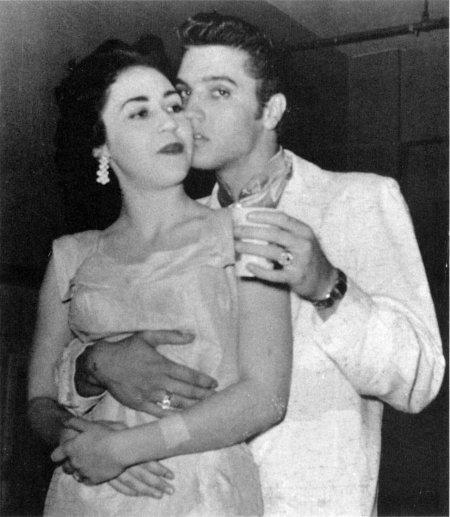
Kay Wheeler and Elvis at the San Antonio Municipal
Auditorium - Apr 15, 1956
Photo courtesy Jim Curtin's Candids of The King
According to Kay, she first heard Elvis sing on a live radio broadcast from the
"Big D Jamboree" in Dallas.
She was visiting her
aunt at work at Radio Station KLIF in Dallas and telling a disc jockey
who hadn't heard of Elvis that "all the girls are just crazy about him...why I've even thought about having a fan club for him!"
Later on the air, the disc jockey, as a joke, announced her name and address as the Elvis Presley Fan club president.
Almost immediately she started receiving large amounts of mail from girls wanting to join the
club. She wrote to Bob Neal who forwarded her letter to Colonel Parker
and was answered by Colonel Parker's assistant, Carolyn Asmus, saying
they had nothing set up regarding fan clubs for Elvis and that the Colonel
said to go ahead and do whatever you want to do for an Elvis Presley Fan Club."
She also mentioned that Elvis was doing a show in San Antonio and if she wanted to
go she could meet Elvis there.4
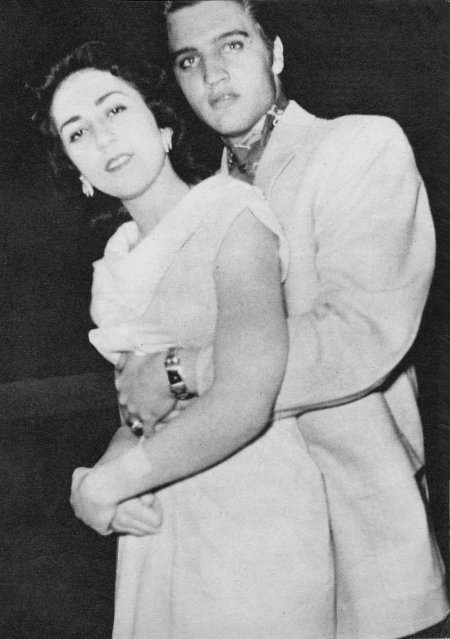
Kay Wheeler and Elvis at the San Antonio Municipal
Auditorium - Apr 15, 1956
Photo courtesy FECC/Elvis_Lady1967
Another similar review of the appearance in the San
Antonio Express was as follows:

ROCK 'N ROLL STAR STIRS NEAR RIOT
3,000 FANS STORM ELVIS PRESLEY'S DRESSING ROOM
By Gerald Ashford
Staff Writer
Elvis Presley, the 21-year-old Memphis boy who has become the hottest
thing in show business since Frank Sinatra's best days, narrowly escaped
being torn to pieces-unintentionally, of course-by a mod of some 3,000
fans who laid siege to the stage door of the Municipal Auditorium Sunday
afternoon.
This occurred after a matinee which was the first of two performances
given here Sunday by Presley and a group of other entertainers, whose
names don't matter. The total audience at the afternoon performance was
around 6,000.
In the melee, one girl fainted and was taken to Presley's dressing
room, where Presley and others, properly chaperoned, applied ice packs
and comforting words. After a few minutes of this, Presley looked into
her eyes and asked her how she felt.
"I feel wonderful" was the inevitable reply.
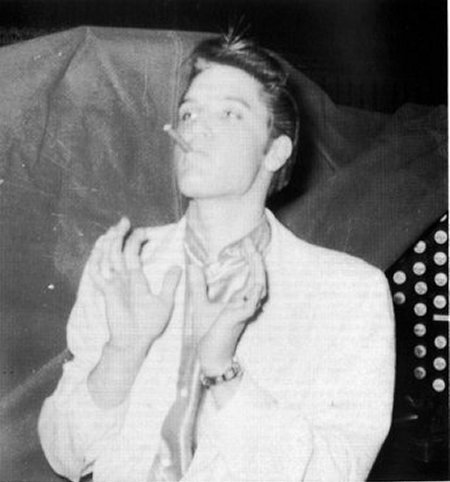
Elvis in between shows at the San Antonio Municipal
Auditorium - Apr 15, 1956
Photo by Kay Wheeler
The near-riot started when Presley's managers placed a table across
the stage door and asked the young people in the crowd to line up for
autographs. But the entire crowd then pressed against the door and the
attempt had to be given up. Others were swarming through all parts of
the Auditorium in a fruitless hunt for their idol.
When Presley made an appearance in a mezzanine window above the stage
door, one young man climbed up the wall and succeeded in getting his
autograph. A few other autographs were handed out through a small barred
window in the dressing room.
Presley, aware from previous experience that it would be impossible
for him to leave the Auditorium just yet, then retired to the keyboard
of the big pipe organ. He had never played any type organ before, but
after picking out a few notes at random he launched into passable
renditions of "Silent Night," "Harbor Lights" and
other tunes.
"These things fascinate me," he said of the pipe organ. He
sang in a church choir, not so long ago, in his home town of Tupelo,
Miss., where he lived until he was 13.
Pointing to the mob outside, a reporter asked, "Do you get this
everywhere you go?"
"Well," Presley replied thoughtfully, "if I said yes
I'd be braggin', but if I said no I'd be lyin'."
His manager chimed in to report, "In Amarillo
they broke the windows."
Hordes of impatient teenagers Sunday night stood their ground at the
Auditorium, with growing cries of "We Want Elvis" as the
singer finished his second performance here.
Presley brought in more than 6,000 fans at Sunday night's show, a few
hundred more than at the afternoon performance.
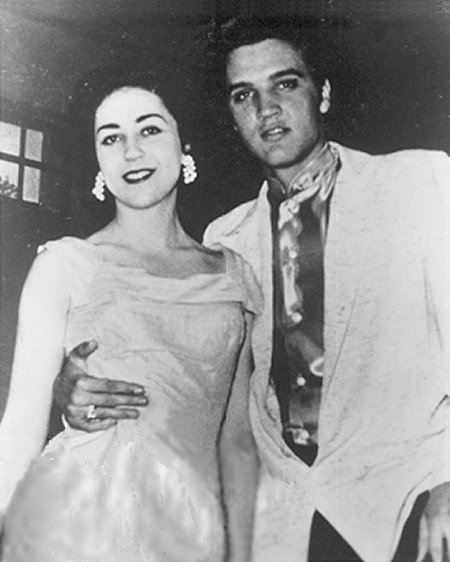
Kay Wheeler and Elvis at the San Antonio Municipal
Auditorium - Apr 15, 1956
Photo courtesy web
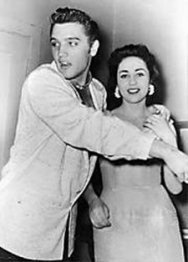 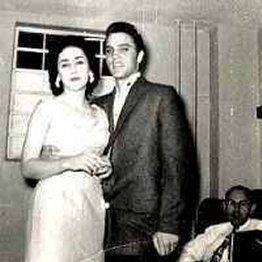
Elvis and Kay Wheeler before 1st and 2nd shows - Apr 15, 1956
Photos courtesy Kay Wheeler and Cristi Dragomir
A few managed to get back stage after the show to get autographs from
the star, and hundreds of others ganged outside his dressing room.
Presley, a young man who seems rather ordinary until he launches into
his act on the stage, made his first commercial recording in Memphis
only 18 months ago. As recently as January of this year he attracted
comparatively little attention here as a supporting member of the Hank
Snow hillbilly troup.
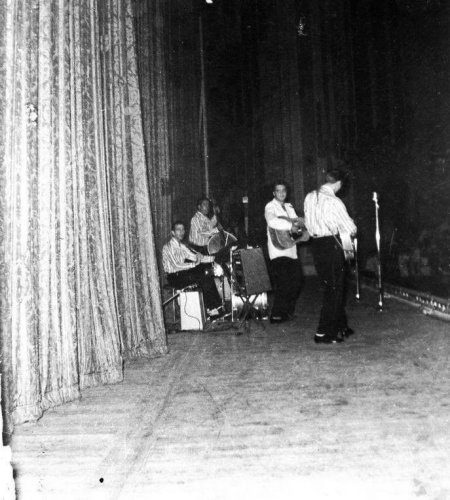
DJ, Bill Elvis and Scotty onstage for 1st show - Apr 15, 1956
Photo by Kay Wheeler courtesy ebay and FECC/Mississippi, added Jan. 16, 2014
His stage acts consists in equal parts of singing, guitar playing and
dancing, the whole being classified, if it can be classified at all, in
the "rock and roll" category.
To an adult ear, all his songs sound pretty much alike, but he puts
them over with tremendous verve and vitality, and keeps it up steadily
for nearly an hour without visible signs of fatigue, even after he
leaves the stage. Perhaps because of his youth, he shows no signs of the
nervous tension or need for rest that is common to older performers who
put forth even half as much energy.
Most of his songs and announcements were half drowned out by a
continuous sound, something between a roar and a squeal, from the
largely teenage audience. This sound and the popping of flash bulbs in
the hands of amateur cameramen-and camera girls-created a convincing
replica of a thunderstorm in the Auditorium.
Just what produced the roars, squeals and other evidences of almost
hysterical joy at Presley's performance will probably forever remain a
closed book to this reviewer, who is over 21. Probably Freud would have
some explanation.
One girl, when asked why she liked Presley, replied matter-of-factly,
"I like him because he looks so mean."
This can hardly be the real reason. Presley doesn't actually look
very mean, and his attitude toward the over-eager autograph hunters was
kindness enough.
San Antonio
Express
- April 16, 1956 courtesy Andy Crews and the
San Antonio Public
Library
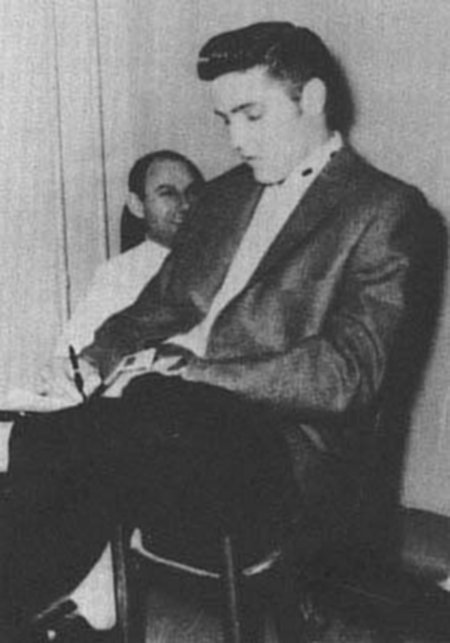
Elvis backstage before 2nd show - Apr 15, 1956
Photos courtesy Cristi Dragomir
On the 19th, the San Antonio Light published this last blurb:
Said one of the local sponsors of the Elvis Presley show the morning after: "I’m afraid I don’t have a
friend left. Everybody wanted to get back stage, begging me to help them do so, but this was impossible.
Orders from the show’s manager were to keep backstage visitors to a minimum, restricting them to
representatives of the daily press, radio and TV. This meant
dozens of teenagers failed to get interviews for their
school papers, not to mention the hundreds of disappointed autograph hunters. San Antonio has never had
such an idol-worshipping audience before. It was just
one of those things."
San Antonio Light - April 19, 1956
courtesy Andy Crews and the
San Antonio Public
Library
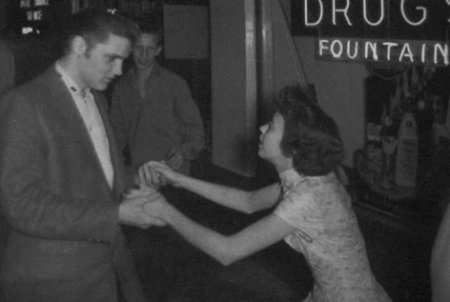
Fans with Elvis after the show - April 15, 1956
Photo courtesy FECC/lewlew

Fans in an elevator with Elvis after the show - April 15, 1956
Photo courtesy FECC/lewlew
As difficult as it was then to get access to Elvis it
would only get worse by the time of the band's next and last appearance
in San Antonio at the Bexar County Coliseum six months later.
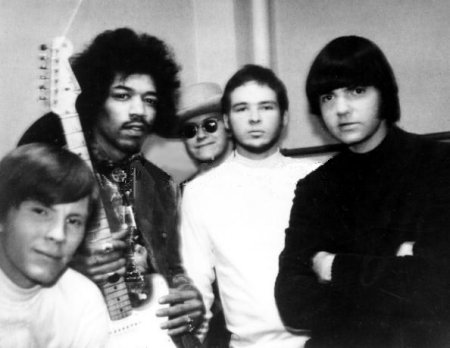
Jimi Hendrix and "The Moving Sidewalks" at the Auditorium
- Feb. 15, 1968
Photo courtesy Getty Images
The Auditorium would eventually host many other rock
acts. On February 15, 1968, Jimi Hendrix performed there and the
opening act was a band called
The Moving Sidewalks,
a 60's psychedelic blues-rock band, most notable for giving future ZZ
Top guitarist Billy Gibbons his start in the music business. As
the story is told, Jimi reputedly gave the
pink Fender Stratocaster
he had at the show to Billy Gibbons who was quoted in
Guitar World
Magazine in 1985 having said "He said the color pink was not conductive to burning, so he gave it to me and said,
'Play on brother.'"
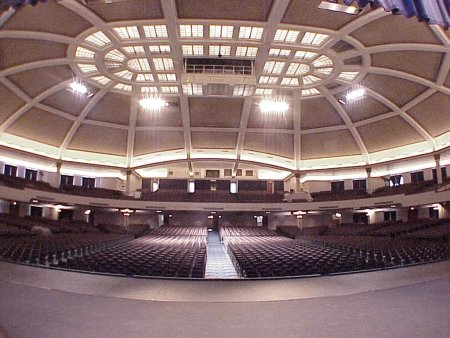
Contemporary view of the Auditorium from the stage
Photo courtesy San
Antonio Convention facilities
On Jan. 6, 1979, a devastating fire destroyed the roof and completely gutted the interior of the auditorium. In 1985, the renovated and modernized building was re-dedicated and though modernized, the stately elegance and grandeur was retained with an abundance of blue-on-white interior spaces and wood-coffered ceilings giving the public areas a Mediterranean
ambience.2
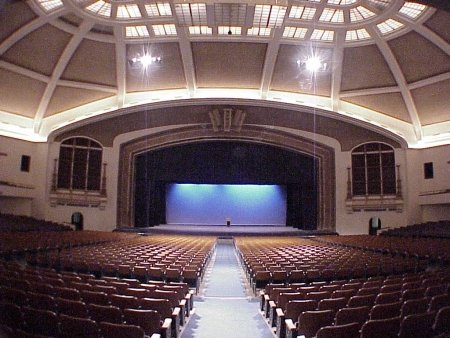
Contemporary view of the auditorium and stage
Photo courtesy San
Antonio Convention facilities
After the renovation the stage was complete with a full complement of curtains, theatrical lighting and a concert quality sound system. The main auditorium
sat 4,884; orchestra section 1,126, first floor sections 1,956, 1,046 in the lower
balcony and 756 in the upper. Two "wing" rooms on either side of the lobby
were each 1,900 square feet and sat 125 theater style. The lower level of the auditorium
was redesigned to yield 23,000 square feet of meeting and exhibit space, the center section of which
sat 400 theater style.2
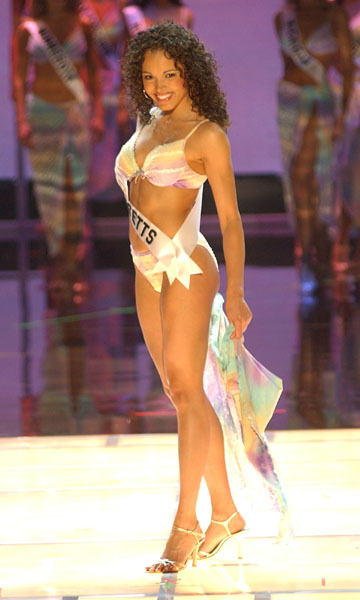
Susie Castillo, Miss Massachusetts/USA 2003 at the
Auditorium - Mar 19, 2003
Photo © Miss
Universe LP, LLLP
In 2003 the city of San Antonio hosted the Miss USA
pageant from the stage set inside San Antonio's Municipal
Auditorium. It was the first time since 1996 it was held in the
state of Texas and the last time that the contest featured only ten
finalists. The title was won by Susie
Castillo representing Massachusetts where she had been born in
Methuen and raised in Lawrence.
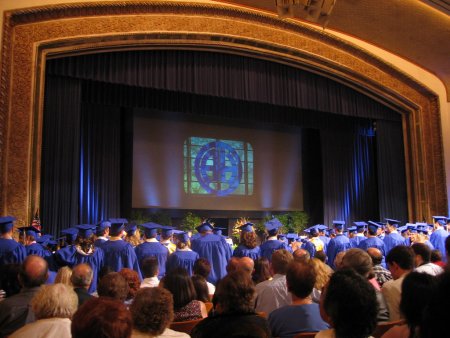
the Alamo Heights HS Class of 2005 graduation at the
Auditorium - May 26, 2005
Photo © Rachel Barenblat
However, in June of 2010 it was announced that the Municipal Auditorium will
be renamed the Tobin Center for the Performing Arts
in honor of a local family known for its arts philanthropy. The Tobin Endowment will commit $15 million to the effort to transform the underutilized auditorium into an acoustically appropriate home for the symphony, opera and ballet
companies, the result of which is believed to be the largest single arts-related donation in San Antonio history.5
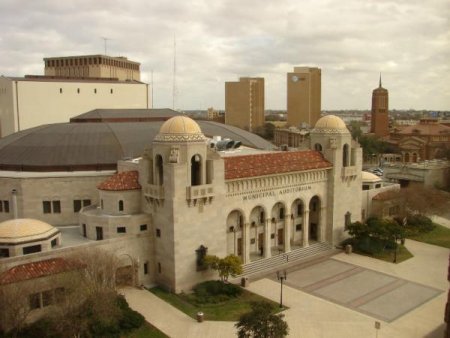
Contemporary view of the San Antonio Municipal Auditorium
Photo courtesy
San Antonio Public
Library
The $15 million comes in the form of a challenge grant, matching dollar for
dollar money raised before the project breaks ground next summer, and will gift the money over a period of several years.
Plans include an exterior restoration that would leave the iconic facade in place, along with
dividing the interior into a series of smaller halls that could host anything from a rock concert to an opera or local theater production.
A plaza with seating for 600 will lead down to the River Walk, opening the building to the river for the first time and providing a space for outdoor concerts and special events.
Completion is targeted for September, 2013.5
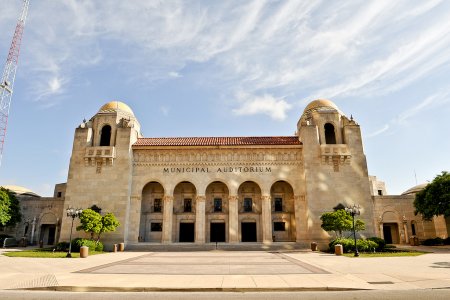
San Antonio Municipal Auditorium - May 9, 2010
Photo © flickr4jazz
Page added September 25, 2010
All ads and articles are courtesy of the
San Antonio Public
Library. Special thanks to Andy Crews, CA Archivist/Librarian
at the San Antonio Public Library for his assistance with this page.
1 courtesy San
Antonio Municipal Auditorium by CitySearch
2 courtesy San
Antonio Convention facilities
3 according
to newspaper and photo captions in the ITC
Library Digital collection
4 according
to "Kay
Wheeler: The Queen of the Rock 'n Bop" by Ronny Weiser - for
the Rockabilly Hall of Fame - March 5, 1998
5 courtesy "Municipal Auditorium gets new
name" by Jennifer Hiller - San Antonio Express June 30, 2010
|




































